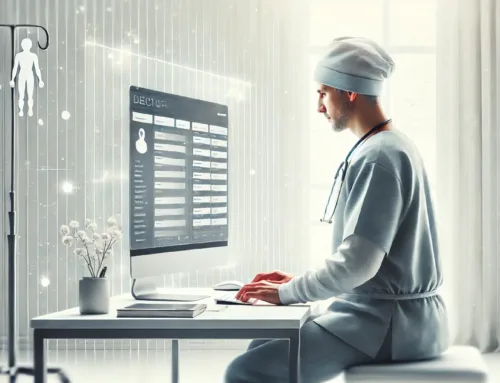You’re constantly tasked with accurately inputting crucial medical data, but are you utilizing the most effective techniques for medical record data entry with efficiency and precision? From medical transcription to patient data management, a multitude of strategies exist to streamline your record-keeping processes and safeguard patient information. Stay tuned to discover how these ten techniques can revolutionize the way you handle medical record data entry, ensuring compliance, accuracy, and data security in your day-to-day operations.
Medical Transcription
When it comes to medical record data entry, one efficient technique is medical transcription. Medical transcription involves converting voice-recorded medical reports dictated by healthcare professionals into written text. This method is crucial for maintaining accurate patient records and streamlining the documentation process. Transcription accuracy is vital in ensuring that the information is correctly transcribed and can be easily accessed and understood by healthcare providers.
Voice recognition technology has revolutionized medical transcription by automating the process of converting spoken words into text. This technology helps to improve efficiency and speed in transcribing medical records, reducing the likelihood of errors associated with manual data entry. By utilizing voice recognition technology, healthcare facilities can enhance transcription accuracy and ensure that patient information is documented promptly and accurately.
Incorporating voice recognition technology into medical transcription not only saves time but also promotes better patient care by providing healthcare professionals with quick access to up-to-date and precise medical records. Embracing this innovative technology can significantly improve the overall efficiency and effectiveness of medical record data entry processes.
Patient Data Management
To effectively manage patient data, healthcare facilities rely on robust systems and protocols that ensure the accuracy and security of sensitive information. Data accuracy is crucial in patient data management to guarantee that medical records are reliable for healthcare providers to make informed decisions. This involves implementing validation checks, regular audits, and staff training to maintain high standards of accuracy.
Record security is another paramount aspect of patient data management. Healthcare facilities must employ encryption methods, access controls, and secure storage solutions to safeguard patient information from unauthorized access or breaches. Regular security assessments and updates are essential to stay ahead of potential threats and ensure patient data remains confidential and protected.
Electronic Health Records
For efficient and comprehensive management of patient health information, electronic health records (EHRs) play a pivotal role in modern healthcare systems. Electronic recordkeeping efficiency is a key benefit of EHRs, enabling healthcare providers to access patient data quickly and accurately. EHRs streamline the process of recording, storing, and retrieving patient information, eliminating the need for paper-based records that are susceptible to errors and loss.
In addition to efficiency, data security compliance is another crucial aspect of EHR systems. To safeguard patient confidentiality and comply with regulations such as HIPAA, EHRs implement robust security measures. These include encryption, access controls, audit trails, and regular data backups to prevent unauthorized access and ensure data integrity.
Medical Coding
Moving from the realm of electronic health records to the domain of medical coding, the accurate translation of patient diagnoses, procedures, and services into universal alphanumeric codes is vital for billing, insurance claims processing, and data analysis in healthcare settings. Coding accuracy is paramount in ensuring that healthcare services are appropriately reimbursed and that data is effectively utilized for decision-making. To achieve this accuracy, healthcare professionals must adhere to documentation guidelines set forth by regulatory bodies. Proper documentation not only supports the coding process but also ensures that the patient’s medical history and treatment are accurately represented in the records. By following documentation guidelines, healthcare providers can streamline the coding process, reduce errors, and improve the overall quality of patient care. Therefore, attention to detail and adherence to documentation standards are crucial in maintaining coding accuracy and optimizing the efficiency of healthcare data management.
Data Quality Control
How can healthcare organizations ensure the accuracy and reliability of their medical record data? To maintain quality control, implementing error prevention techniques and data validation methods is crucial. Error prevention techniques involve training staff on accurate data entry practices and utilizing software with built-in error alerts. Data validation methods include cross-referencing data with patient information to ensure accuracy.
Data accuracy verification is another key aspect of quality control. Regular audits of medical records can help identify discrepancies and ensure data integrity. Quality assurance strategies, such as implementing standardized protocols for data entry and conducting periodic reviews, can also enhance data accuracy.
Health Information Management
Ensuring effective health information management is essential for healthcare organizations to maintain accurate and organized medical records. Data accuracy is crucial to provide quality patient care and support clinical decision-making. Health information management involves various processes to ensure data integrity and reliability. One key aspect is implementing protocols for verifying the correctness of information entered into electronic health records. Regular audits and checks help identify and rectify any errors promptly, enhancing the overall accuracy of medical records.
Record organization is another vital component of health information management. Properly organizing medical records facilitates easy retrieval of information when needed, streamlining patient care processes. Implementing standardized procedures for structuring and categorizing data ensures consistency across all records. Utilizing electronic health record systems with robust search functionalities can further aid in efficiently organizing and accessing patient information.
Confidentiality Protocols
To uphold patient privacy and trust, healthcare facilities must adhere to stringent confidentiality protocols. Access control is a critical component of maintaining confidentiality in medical record data entry. This involves limiting access to patient information only to authorized personnel, ensuring that sensitive data is not viewed or altered by individuals without proper clearance. Information security measures are also essential in safeguarding patient data. Healthcare facilities must implement encryption, firewalls, and secure networks to prevent unauthorized access or data breaches. Regular security audits and updates are necessary to stay ahead of potential threats and ensure that patient information remains confidential. By enforcing strict access control and robust information security protocols, healthcare facilities can uphold patient confidentiality, build trust with patients, and comply with regulations governing the privacy of medical records.
Data Entry Software
When considering data entry software for medical records, it’s crucial to evaluate the software features that align with your specific needs. Look for software that offers comprehensive training and ongoing support to ensure efficient utilization of the system. These aspects are essential for streamlining the data entry process and maintaining accuracy in medical record documentation.
Software Features
The software features of data entry software play a crucial role in streamlining the process of inputting medical records efficiently and accurately. Data validation techniques ensure that only accurate and relevant information is entered, reducing errors and improving data quality. Software integration capabilities allow seamless connectivity with other systems, enabling easy access to patient records across different platforms.
User interface customization options enable users to tailor the software to their specific needs, optimizing workflow and enhancing user experience. This customization can include personalized templates, shortcuts, and layouts that match individual preferences and requirements.
Data security measures are essential in medical record data entry software to protect sensitive patient information. Features like encryption, access controls, and audit trails help maintain confidentiality and compliance with privacy regulations. Robust security protocols safeguard against unauthorized access and ensure data integrity throughout the input process.
Incorporating these software features can significantly enhance the efficiency, accuracy, and security of medical record data entry processes.
Training and Support
Effective training and support are crucial components for maximizing the efficiency and accuracy of data entry software in medical record management. Proper training ensures that users understand the software’s features and functions, enabling them to navigate through the system with ease. Support should be readily available to address any issues or questions that may arise during data entry tasks, ensuring seamless workflow optimization.
Training sessions should focus on best practices for data entry, emphasizing techniques for error prevention. Providing hands-on practice opportunities can help users familiarize themselves with the software, reducing the likelihood of mistakes. Additionally, ongoing support through help desks or online resources can aid users in troubleshooting any technical issues quickly.
Health Data Standards
When it comes to medical record data entry, understanding health data standards is crucial. Data interoperability plays a significant role in ensuring seamless communication between healthcare systems and providers. Standardization benefits include improved data accuracy, streamlined processes, and better patient care outcomes. Implementing HL7 standards can enhance data exchange efficiency and promote interoperability across different healthcare platforms.
Data Interoperability Importance
Implementing proper health data standards is crucial for ensuring seamless data interoperability in medical record data entry. In the healthcare industry, data integration across various healthcare systems and efficient data sharing among healthcare providers are essential for delivering high-quality patient care. Here are three key reasons why data interoperability is of utmost importance:
- Improved Patient Care: Seamless data interoperability allows healthcare providers to access comprehensive patient information quickly. This leads to faster decision-making, accurate diagnoses, and effective treatment plans.
- Enhanced Efficiency: When data is interoperable, healthcare professionals can streamline workflows, reduce duplicate data entry, and minimize errors. This efficiency improvement translates into time savings and better resource utilization.
- Interconnected Healthcare Ecosystem: Data interoperability fosters collaboration between different healthcare entities, enabling secure and efficient data exchange. This interconnected ecosystem promotes continuity of care, reduces administrative burdens, and ultimately enhances the overall healthcare experience for patients.
Standardization Benefits
To maximize the efficiency and effectiveness of medical record data entry, the adoption of standardized health data formats and protocols is paramount. Standardization offers numerous benefits, with data accuracy being a primary advantage. By following standardized formats and protocols, healthcare professionals can ensure that the data entered is consistent and reliable, reducing the risk of errors and discrepancies.
Moreover, standardization leads to efficiency improvements in medical record data entry processes. When everyone within a healthcare facility uses the same formats and protocols, it streamlines the data entry process. This consistency saves time and minimizes the need for manual corrections or rework. As a result, healthcare providers can focus more on patient care rather than getting bogged down by data entry tasks.
Implementing HL7 Standards
For streamlined and efficient medical record data entry, the adoption of HL7 Standards (Health Data Standards) is essential. Implementing HL7 Standards can significantly enhance interoperability and data exchange in healthcare settings. Consider the following key points to ensure successful HL7 implementation:
- HL7 Implementation Challenges: Addressing interoperability issues, aligning systems to HL7 standards, and ensuring data security and privacy are common challenges faced during HL7 implementation. Overcoming these hurdles requires meticulous planning and a collaborative approach among stakeholders.
- Data Entry Efficiency Techniques: Utilize standardized templates and forms to facilitate consistent data entry practices. Implementing automated data entry tools and validation mechanisms can help reduce errors and streamline the process. Training staff on HL7 standards and best practices is crucial for maximizing data entry efficiency.
- Integration with Existing Systems: Ensure seamless integration of HL7 standards with existing Electronic Health Record (EHR) systems and other healthcare IT infrastructure. Conduct thorough testing and validation to guarantee smooth data exchange and interoperability between systems.
Patient Identification Accuracy
Ensuring precise patient identification accuracy within medical record data entry is crucial for maintaining the integrity and reliability of health records. Data validation plays a key role in confirming the accuracy of patient information entered into the system. By implementing validation checks, such as requiring unique identifiers like a medical record number or national identification number, errors in patient identification can be significantly reduced.
Error prevention strategies are essential in maintaining patient identification accuracy. Utilizing barcode scanning technology can help streamline the data entry process and minimize the risk of manual entry errors. Additionally, implementing biometric identification methods, such as fingerprint or iris scans, can enhance patient identification accuracy by ensuring unique patient verification. Regular audits and reviews of patient data can help identify and rectify any discrepancies in patient information, further enhancing data accuracy.
Frequently Asked Questions
How Can Medical Record Data Entry Improve Patient Outcomes?
To improve patient outcomes, medical record data entry allows for enhanced patient engagement and supports informed clinical decision making. By accurately documenting and tracking patient information, healthcare providers can provide more personalized and effective care.
What Are the Best Practices for Ensuring Data Accuracy in Medical Records?
To ensure data accuracy in medical records, focus on implementing training programs for staff and rigorous quality control measures. These strategies help maintain precise information, reducing errors and improving patient care outcomes.
How Do Data Entry Software Options Differ in the Healthcare Industry?
Navigating through data entry software in healthcare can be like choosing a path in a maze. Some options prioritize efficiency, streamlining tasks for smoother user experience. Understanding these differences can enhance your workflow significantly.
Are There Specific Regulations Regarding Data Entry for Medical Records?
Regulatory requirements for medical record data entry are crucial. They ensure data integrity, accuracy, and confidentiality. Compliance with laws such as HIPAA is key. Continuous training on proper data entry practices is essential for meeting these standards.
How Can Healthcare Organizations Ensure Secure Data Entry Processes?
To ensure secure data entry processes in healthcare organizations, implement data encryption and access controls. Train users on proper data entry protocols and establish audit trails for monitoring. These steps enhance security and protect sensitive medical information.




